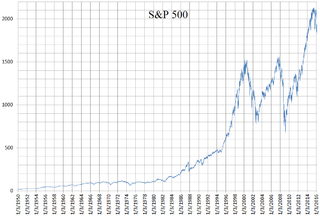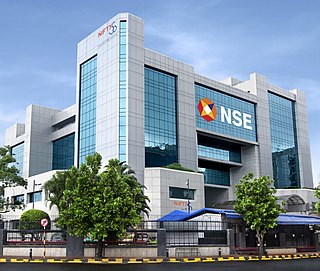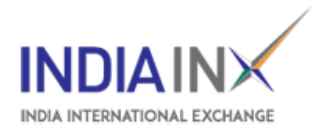
A stock exchange, securities exchange, or bourse is an exchange where stockbrokers and traders can buy and sell securities, such as shares of stock, bonds and other financial instruments. Stock exchanges may also provide facilities for the issue and redemption of such securities and instruments and capital events including the payment of income and dividends. Securities traded on a stock exchange include stock issued by listed companies, unit trusts, derivatives, pooled investment products and bonds. Stock exchanges often function as "continuous auction" markets with buyers and sellers consummating transactions via open outcry at a central location such as the floor of the exchange or by using an electronic trading platform.

The Standard and Poor's 500, or simply the S&P 500, is a stock market index tracking the stock performance of 500 of the largest companies listed on stock exchanges in the United States. It is one of the most commonly followed equity indices. As of December 31, 2021, according to surveys, more than $7.1 trillion was invested in assets tied to the performance of the index.

National Stock Exchange of India Limited is one of the leading stock exchanges in India, based in Mumbai. NSE is under the ownership of various financial institutions such as banks and insurance companies. It is the world's largest derivatives exchange by number of contracts traded and the third largest in cash equities by number of trades for the calendar year 2022. It is one of the largest stock exchanges in the world by market capitalization. NSE's flagship index, the NIFTY 50, a 50 stock index is used extensively by investors in India and around the world as a barometer of the Indian capital market. The NIFTY 50 index was launched in 1996 by NSE.

The BSE SENSEX is a free-float market-weighted stock market index of 30 well-established and financially sound companies listed on the Bombay Stock Exchange. The 30 constituent companies which are some of the largest and most actively traded stocks, are representative of various industrial sectors of the Indian economy. Published since 1 January 1986, the S&P BSE SENSEX is regarded as the pulse of the domestic stock markets in India. The base value of the SENSEX was taken as 100 on 1 April 1979 and its base year as 1978–79. On 25 July 2001 BSE launched DOLLEX-30, a dollar-linked version of the SENSEX.

The NIFTY 50 is a benchmark Indian stock market index that represents the weighted average of 50 of the largest Indian companies listed on the National Stock Exchange.
Russell indexes are a family of global stock market indices from FTSE Russell that allow investors to track the performance of distinct market segments worldwide. Many investors use mutual funds or exchange-traded funds based on the FTSE Russell Indexes as a way of gaining exposure to certain portions of the U.S. stock market. Additionally, many investment managers use the Russell Indexes as benchmarks to measure their own performance. Russell's index design has led to more assets benchmarked to its U.S. index family than all other U.S. equity indexes combined.

NIFTY 500 is India’s first broad-based stock market index of the Indian stock market. It contains top 500 listed companies on the NSE. The NIFTY 500 index represents about 96.1% of free float market capitalization and about 96.5% of the total turnover on the National Stock Exchange (NSE).

The S&P Europe 350 Index is a stock index of European stocks.
The S&P 100 Index is a stock market index of United States stocks maintained by Standard & Poor's.
The EURO STOXX 50 is a stock index of Eurozone stocks designed by STOXX, an index provider owned by Deutsche Börse Group. The index is composed of 50 stocks from 11 countries in the Eurozone.
Index arbitrage is a subset of statistical arbitrage focusing on index components.
The KSE-30 Index is a stock market index which tracks the performance of the top 30 most liquid companies listed on the stock exchanges in Pakistan. The index is based on a free float methodology in differentiation to other indices based of paid-up capital.
The S&P/ASX 20 index is a stock market index of stocks listed on the Australian Securities Exchange from Standard & Poor's. While the "ASX 20" often simply refers to the 20 largest companies by market capitalisation, the S&P/ASX 20 Index is calculated by using the S&P Dow Jones Indices market capitalization weighted and float-adjusted methodologies. All 20 companies also feature in the S&P/ASX 50.
The S&P/ASX 300, or simply, ASX 300, is a stock market index of Australian stocks listed on the Australian Securities Exchange (ASX). The index is market-capitalisation weighted, meaning each company included is in proportion to the indexes total market value, and float-adjusted, meaning the index only considers shares available to public investors.
The S&P MidCap 400 Index, more commonly known as the S&P 400, is a stock market index from S&P Dow Jones Indices. The index serves as a gauge for the U.S. mid-cap equities sector and is the most widely followed mid-cap index. It is part of the S&P 1500, which also includes the S&P 500 for larger U.S. based companies, and the S&P 600 for smaller companies though all three indices include a handful of foreign stocks that trade on the U.S. stock exchanges.

In finance, a stock index, or stock market index, is an index that measures the performance of a stock market, or of a subset of a stock market. It helps investors compare current stock price levels with past prices to calculate market performance.
The S&P SL20, or the Standard & Poor's Sri Lanka 20, is a stock market index, based on market capitalization, that follows the performance of 20 leading publicly traded companies listed in the Colombo Stock Exchange. The 20 companies that make up the index is determined by Standard & Poor's global index methodology, according to which the index's listing is reviewed each year. All S&P SL20 listed stocks are classified according to S&P and MSCI's Global Industry Classification Standard, thereby enabling better comparison of performance of Sri Lanka's largest and most liquid stocks with other global indices.

The India International Exchange Limited (India INX) is India's first international stock exchange which is launched as a subsidiary of the Bombay Stock Exchange (BSE). It is located at the International Financial Services Centre, GIFT City in Gujarat.
Since the beginning of the Bombay stock exchange, stock markets in India, particularly the Bombay Stock Exchange and National Stock Exchange of India have seen a number of booms as well as crashes.








